Table of contents
- Variable valve controls Ducati Multistrada 1200 DVT, Kawasaki GTR 1400, Honda VFR 800 Sorcery or frippery?
- Lots of valve overlap good for top performance
- On the Multistrada 1200 DVT, both camshafts are twisted
- A knock sensor on the cylinder head is new
- Multistrada valve control
- Valve control GTR 1400
- Valve control VFR 800
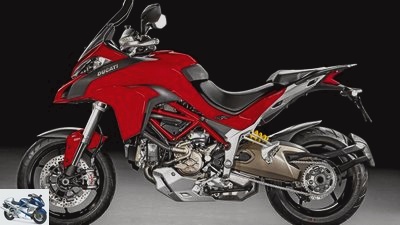
Ducati
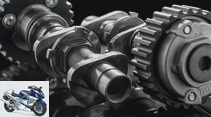
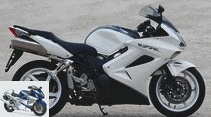
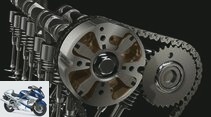
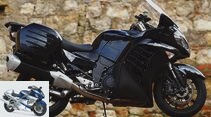
10 pictures
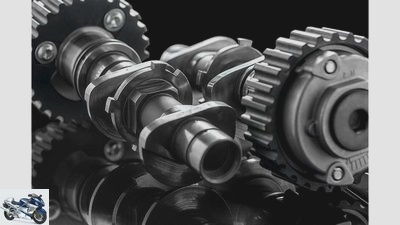
Ducati
1/10
…compact, rotatable hydraulic units on each camshaft, variable timing. The pulse generators for the position of the camshafts are clearly visible between the cams.
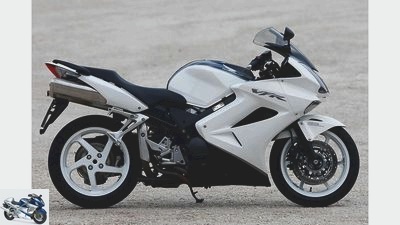
fact / Joachim Schahl
2/10
Honda VFR 800: Honda has designed a mechanism below the bucket tappets for the VFR 800 models, which switches off the respective valve below a certain speed limit.

Kawasaki
3/10
The hydraulic actuator is only located on the intake camshaft, the principle is the same as with Ducati. Here, too, the goal is to make the combustion more effective in the lower speed range in order to get a better torque curve with reduced consumption.
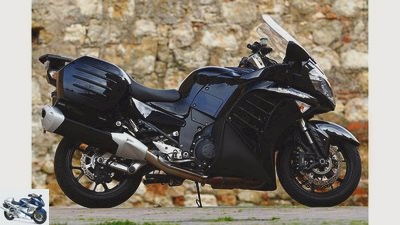
Gargolov
4/10
Kawasaki GTR 1400: The Japanese were the first to have hydraulically rotatable timing chain sprockets go into series production on the GTR 1400 from 2010 onwards.
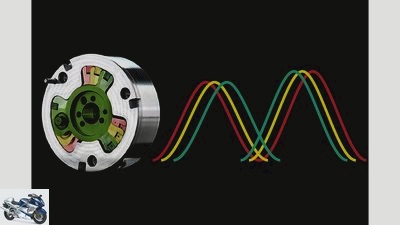
Source: Ducati
5/10
…a wide range of valve overlap. A look at the red line in the timing diagram shows that the exhaust valve (left side) is already completely closed when the intake valve starts to open. In the other extreme case (green line) an overlap is possible as with the super sports car. Between these extremes, the electronics continuously regulate the valve timing depending on the throttle valve position and engine speed.
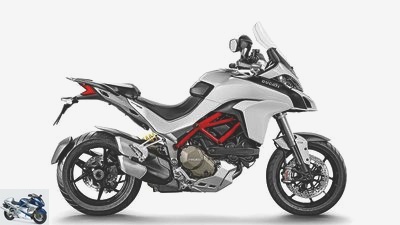
Ducati
6/10
…Changes to the chassis, engine and equipment.
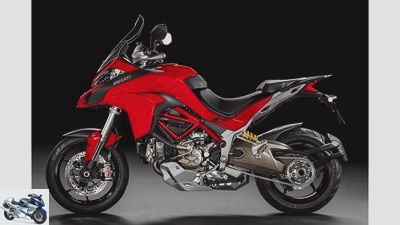
Ducati
7/10
Multistrada 1200 DVT: not an upgrade, but a completely new motorcycle with many…
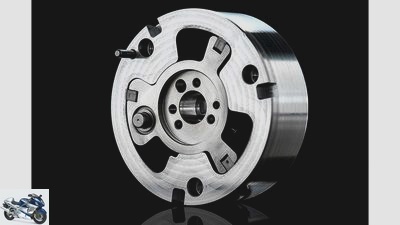
Ducati
8/10
Ducati Multistrada: The hydraulic actuators of each camshaft allow 22.5 degrees of rotation. This results in…

Ducati
9/10
DVT – Desmodromic Variable Timing: allow with the Testastretta-Twin…
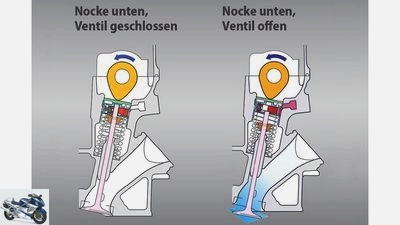
Source: Honda
10/10
For this purpose, a small locking pin is moved via the control hydraulics so that the valve either remains closed or is opened by the cam. The engine works like a two-valve engine in the lower speed range, and then as a four-valve engine at the top. The switching is more or less noticeable. The benefits are controversial. Some drivers appreciate this leap in the performance characteristics, which can also be clearly perceived acoustically.
counselor
technology & future
Variable valve controls
Variable valve controls Ducati Multistrada 1200 DVT, Kawasaki GTR 1400, Honda VFR 800
Sorcery or frippery?
Variable valve timing is widespread in car engines today. Now this technology is also increasingly being used in motorcycles. With the new Ducati Multistrada 1200 DVT, this should bring more torque, less consumption and more smooth running. And how do the variable valve controls work on other models such as the Honda VFR 800 and Kawasaki GTR 1400?
Gert Thole
01/08/2015
In principle, an internal combustion engine is solid, but simple mechanics, even if a lot of electronics are involved nowadays. But what really matters is what happens in the combustion chamber. When the air-fuel mixture is burned, pressure is created, from which the drive torque is generated via the piston and crankshaft. Characteristics, running smoothness or consumption are therefore primarily determined here. An important factor for efficient combustion in the four-stroke engine is the timing, which is specified by the cam profile and is therefore initially fixed. But that is actually not ideal, it would rather be variable timing, plus perhaps a flexible valve lift, depending on the load condition and engine speed. Inflatable cams would be a good idea, but they don’t exist yet.
Buy complete article
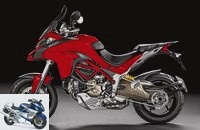
Variable valve controls Ducati Multistrada 1200 DVT, Kawasaki GTR 1400, Honda VFR 800
Sorcery or frippery?
4 pages) as PDF
€ 2.00
Buy now
Therefor mechanical solutions. In many current car models, very complex variable valve controls work unobtrusively under the hood. Some vary the timing by switching to different cam profiles, some the valve lift using complicated mechanics / hydraulics, some do both. In some car engines, BMW even dispenses with the usual throttle valve control and regulates the speed solely via the valve lift (Valvetronic). This requires a lot of mechanics, hydraulics and electronics, expensive, complicated, heavy and bulky. That’s why it doesn’t yet exist in a motorcycle.
Lots of valve overlap good for top performance
Simpler solutions, however, have been around for many years. Honda’s Vtec valve control, for example, has simply switched off one inlet and one outlet valve each in the four-valve engines of the Honda VFR 800 since 2002 in the lower speed range. At the top the engine works as a four-valve engine, at the bottom as a two-valve engine. Actually a smart idea, but it hasn’t really caught on yet. Going a different way Kawasaki for the Kawasaki GTR 1400. From model year 2010, the designers integrated a compact hydraulic unit on the timing chain sprocket of the inlet camshaft, which rotates the drive wheel with respect to the camshaft, electronically controlled by hydraulics.
What’s the point? Above all, it has a considerable influence on the valve overlap. This is the time when the intake and exhaust valves are briefly open simultaneously at the end of the exhaust stroke. A lot of valve overlap is good for performance at high engine speeds, as the combustion gases flowing into the exhaust draw fresh gas into the combustion chamber and flush the cylinder. That brings a better filling and thus more performance. You have to keep in mind that the gas oscillations in an engine are a complex matter and depend on many parameters. Outside of the engine, for example, one tries to influence it with tricks such as exhaust flaps or variable intake funnels. But back to the valve overlap: As I said, a lot is good for peak performance, but not good for performance at low speeds, as the charging effect does not work. It is also not good for the smoothness in the partial load range, exhaust emissions and fuel consumption. A variable overlap is therefore a logical idea.
MotoGP technology: valve trains
Sex offender
read more

technology & future
PS technology series part 2
Valve control and gas exchange
read more
PDF download PS technology special
On the Multistrada 1200 DVT, both camshafts are twisted
Ducati twisted at the new one Ducati Multistrada 1200 DVT both camshafts at the same time, which of course opens up even more possibilities. So far, the Testastretta-V2 had eleven degrees of valve overlap in the Multistrada, but a full 41 degrees in the 1198 super sports car. It must be mentioned that the Ducati-V2, thanks to the Desmodromic, run with fairly sharp timing, i.e. high valve accelerations, which is why they hammer hard and rough, especially when there is a large overlap.
The elevation curves of the DVT engine published so far suggest that Ducati the overlap varies from near zero degrees to over 50 degrees. The two three-blade actuators allow each camshaft to be just over 20 degrees. According to Ducati, DVT should bring enormous advantages, primarily in terms of torque, of course. An increase from 125 to 136 Nm is promised, an extraordinary value for a 1200. BMW and KTM, for example, specify 125 Nm for their 1200 enduros. At the same time, the top performance of the Ducati increases Multistrada 1200 DVT to a whopping 160 hp, which is only 10 hp away from the last 1198. Consumption should be reduced by eight percent compared to the previous model.
A knock sensor on the cylinder head is new
Perhaps even more important are the advantages in terms of running culture. Ducati measures the so-called Imep coefficient, which is a measure of the uniformity of combustion. Each individual combustion is compared with the previous one. When filling the huge combustion chambers, irregularities always occur, which caused the rumbling idling of earlier Ducati engines. The response behavior in the lower speed and load range also suffered. The eleven-degree Testastretta with double ignition brought a noticeable improvement, but the new DVT engine is said to have been 78 percent better in this regard. According to Ducati measurements, it clearly outperforms “a well-known competitor”, which obviously means the current GS-BMW. We’ll see.
The drive of the Ducati Multistrada 1200 DVT could take a big step forward. Accompanying measures are intended to intensify these effects. The Testastretta already had double ignition recently, a knock sensor on the cylinder head is new. And the modern on-board electronics open up endless possibilities for tuning, the engine characteristics in the different driving programs could be spread even more thanks to DVT. So much for the theory. But let’s see how it all works in practice. One thing can certainly be predicted now: other manufacturers will jump on this bandwagon. We bet that test engines are already running on Munich test stands?
Multistrada valve control
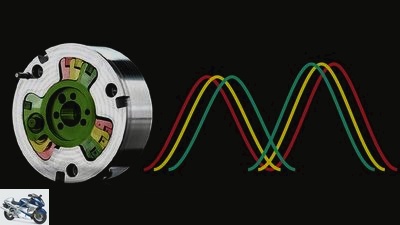
Source: Ducati
The hydraulic actuators on each camshaft allow a rotation angle of 22.5 degrees.
Ducati Multistrada 1200 DVT
The hydraulic actuators on each camshaft allow a rotation angle of 22.5 degrees. This results in a wide range of valve overlap. A look at the red line in the timing diagram shows that the exhaust valve (left side) is already completely closed when the intake valve starts to open. In the other extreme case (green line) an overlap is possible as with the super sports car. Between these extremes, the electronics continuously regulate the valve timing depending on the throttle valve position and engine speed.
All tests and articles about the Ducati Multistrada 1200
Valve control GTR 1400
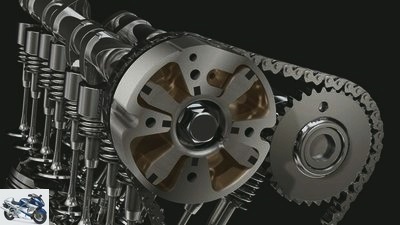
Kawasaki
The hydraulic actuator is only located on the intake camshaft, the principle is the same as with Ducati.
Kawasaki GTR 1400
The Japanese were the first to have hydraulically rotatable timing chain sprockets go into series production on the Kawasaki GTR 1400 from 2010 onwards. The hydraulic actuator is only located on the intake camshaft, the principle is the same as with Ducati. Here, too, the goal is to make the combustion more effective in the lower speed range in order to get a better torque curve with reduced consumption. However, progress was limited.
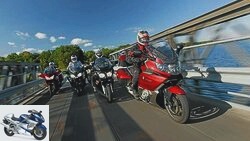
Tourer
Comparative test tourer
Comparison of tourers from BMW, Kawasaki, Yamaha and Honda
read more
All articles about the Kawasaki 1400 GTR
Valve control VFR 800
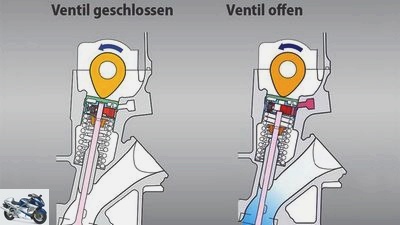
Source: Honda
The engine works like a two-valve engine at the bottom and then as a four-valve engine at the top.
Honda VFR 800
Honda has designed a mechanism below the bucket tappets for the VFR 800 models, which switches off the respective valve below a certain speed limit. For this purpose, a small locking pin is moved via the control hydraulics so that the valve either remains closed or is opened by the cam. The engine works like a two-valve engine at the bottom and then as a four-valve engine at the top. The switching is more or less noticeable. The benefits are controversial. Some drivers appreciate this leap in the performance characteristics, which can also be clearly perceived acoustically.
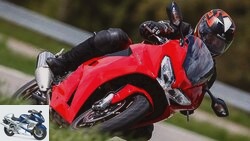
Tourer
Honda VFR 800 F in the top test
Running miracle reissued
read more
Related articles
-
Suzuki patent: Variable valve control 2.0
Suzuki 8th pictures Suzuki 1/8 Suzuki is working on a new variable valve control. Suzuki 2/8 It should serve the inlet and outlet and be hydraulically…
-
Honda patent new variable valve timing
Honda 12th pictures Honda 1/12 Honda has patented a new variable valve control. Honda 2/12 The new variable valve control in the engine of the upcoming…
-
MotoGP technology: valve trains
counselor workshop MotoGP technology: valve trains MotoGP technology: valve trains Sex offender Stoner? Traction control? Tire technology? Happiness? It…
-
Yamaha counselor technology & future Valve control gas exchange PS technology series part 2 Valve control and gas exchange Content of Almost exactly four…
-
Screwdriver tip on the subject of valve control
Ralf Petersen 15th pictures Ralf Petersen 1/15 The valve train controls the gas exchange in a four-stroke engine with the help of the inlet and outlet…
-
Marcus Jahn 38 pictures BMW motorcycle 1/38 BMW fire engine BMW R 1200 RT. BMW motorcycle 2/38 BMW R 1200 RT police motorcycle. BMW motorcycle 3/38 BMW…
-
Technology development in valve actuation
factstudio.de 23 pictures Katrin Sdun 1/23 Before valve actuation via rocker arms prevailed, numerous other designs determined the state of the art. Ralf…
-
Adjust the valve clearance on the BMW boxer
Schermer counselor workshop Adjust the valve clearance on the BMW boxer Screwdriver tip Adjust the valve clearance on the BMW boxer Thanks to the exposed…
-
Ducati Multistrada V4 recall: engine replacement after valve problems
Ducati 45 pictures Ducati 1/45 Ducati brings the new Multistrada with a V4 engine. Ducati 2/45 Ducati has made the Multistrada even more versatile….
-
Test: retrofittable traction controls
fact accesories Test: retrofittable traction controls Test: retrofittable traction controls Traction controls from Bazzaz, Grip One and IRC Content of…